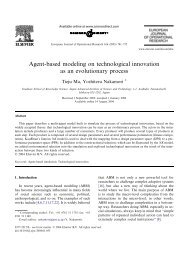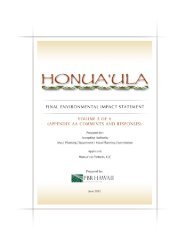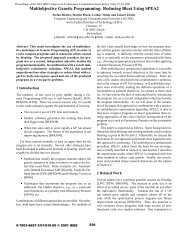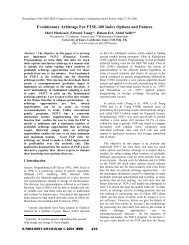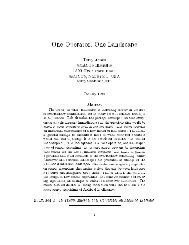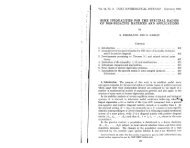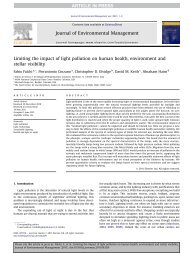draft eis comments and responses - Lee Altenberg
draft eis comments and responses - Lee Altenberg
draft eis comments and responses - Lee Altenberg
Create successful ePaper yourself
Turn your PDF publications into a flip-book with our unique Google optimized e-Paper software.
May 31, 2012<br />
University of Hawaiÿi at Mänoa<br />
Environmental Center<br />
2500 Dole Street, Krauss Annex 19<br />
Honolulu, Hawaiÿi 96822<br />
SUBJECT: HONUA‘ULA DRAFT ENVIRONMENTAL IMPACT STATEMENT AND<br />
PROJECT DISTRICT PHASE II APPLICATION<br />
Dear Environmental Center:<br />
We have received the letter from the Environmental Center letter dated June 30, 2010<br />
addressed to Charles Jencks regarding the Honuaÿula Draft Environmental Impact<br />
Statement (EIS) <strong>and</strong> Project District Phase II application. As the planning consultant for the<br />
l<strong>and</strong>owner, Honua‘ula Partners, LLC, we are responding to the Environmental Center’s<br />
<strong>comments</strong>. The organization of this letter follows the headings of your letter.<br />
Honuaÿula Purpose <strong>and</strong> Need<br />
Question/Comment: The last paragraph on page 21 points out the economic benefits<br />
including “over seven million dollars in annual property tax revenue to the County of<br />
Maui.” It fails to mention that the project will incur considerable cost in terms of<br />
infrastructure <strong>and</strong> services the county <strong>and</strong> state will have to provide with the tax revenue.<br />
In this case, the benefits of tax revenue may be greater than the costs of services as your<br />
consultants had deduced, but in some cases of residential development the cost of services<br />
provided is greater than the revenue collected.<br />
Response: The information provided on page 21 of the Draft EIS to which you refer was an<br />
overview of the economic impact of Honua‘ula. A more complete discussion of economic<br />
benefits is provided in Section 4.9.5 (Economy) of the Draft EIS <strong>and</strong> in Appendix Q, which<br />
contains the complete Market Study, Economic Impact Analysis, <strong>and</strong> Public Costs/Benefits<br />
Assessment. That assessment: 1) estimates the general <strong>and</strong> specific effects on the economy<br />
which will result from the creation of Honua‘ula, including construction <strong>and</strong> business<br />
employment, wages <strong>and</strong> income, resident expenditures, regional monetary <strong>and</strong><br />
employment effects, <strong>and</strong> taxes <strong>and</strong> fees accruing to the County of Maui <strong>and</strong> State of<br />
Hawaii; <strong>and</strong> 2) compares these economic benefits of Honua‘ula with the projected costs to<br />
the State <strong>and</strong> County for providing government services as a result of Honua‘ula.<br />
As discussed in Section 4.9.5 (Economy) of the Draft EIS, in no year will the State or the<br />
County suffer a revenue shortfall due to Honua‘ula. Further, as projected, the County of<br />
Maui will receive approximately $81.1 million in real property tax revenues from<br />
Honua‘ula over the 13-year build-out period, <strong>and</strong> an estimated $7.25 million per year<br />
thereafter. The County government operating costs associated with serving the community,<br />
using a per capita basis, is estimated to total $39.3 million during the 13-year build-out<br />
period <strong>and</strong> stabilize at approximately $5.65 million per year after build-out. Therefore, the<br />
County will enjoy a net revenue benefit (taxes less costs) totaling approximately $41.8<br />
million during the 13-year construction period, <strong>and</strong> $1.6 million each year after build-out.<br />
Environmental Center<br />
SUBJECT: HONUAÿULA DRAFT ENVIRONMENTAL IMPACT STATEMENT AND PROJECT<br />
DISTRICT PHASE II APPLICATION<br />
May 31, 2012<br />
Page 2 of 23<br />
It is projected that the State of Hawai‘i will show a similar positive net revenue benefit from<br />
Honua‘ula. The total gross tax revenues during the 13-year build-out period will reach<br />
approximately $165 million from income <strong>and</strong> gross excise taxes, <strong>and</strong> will stabilize at<br />
approximately $11.3 million per year after build-out. State costs associated with the community<br />
on a per capita basis are projected to be $68.2 million during the 13-year build-out period <strong>and</strong><br />
are projected to stabilize at approximately $9.8 million per year after build-out. Therefore, the<br />
State will experience a net profit of approximately $97 million in the 13-build-out <strong>and</strong> sales<br />
period <strong>and</strong> a stabilized benefit of approximately $1.5 million per year after build-out.<br />
In addition to State <strong>and</strong> County taxes, Honua‘ula will also pay specific development fees in<br />
compliance with County of Maui Ordinance No. 3554. These fees include:<br />
Traffic improvement fees of $5,000 per residential unit, payable to the County of Maui;<br />
Park assessment fees, currently at $17,240 per residential unit, payable to the County of<br />
Maui; <strong>and</strong><br />
School impact fee, currently at least $3,000 per residential unit, payable to the State.<br />
Together, these fees are at least $25,240 per residential unit <strong>and</strong> total over $29 million.<br />
In addition, Honua‘ula Partners, LLC will also:<br />
Pay not less than $5 million to the County for the development of the South Maui<br />
Community Park in-lieu of dedicating a Little League Field within Honua‘ula;<br />
Contribute $550,000 to the County for the development of the new Kïhei District Police<br />
Station in South Maui; <strong>and</strong><br />
Provide the County two acres of l<strong>and</strong> with direct access to the Pi‘ilani Highway extension<br />
for the development of a fire station.<br />
Single- <strong>and</strong> Multi-Family Residential Sub-districts<br />
Question/Comment: The DEIS states that 250 of the workforce houses will be built off-site at the<br />
Kaonoulu Light Industrial Subdivision, but no mention is made of the impact of these homes. Yet,<br />
they are part of the proposed project <strong>and</strong> will add to the impacts that the project will cause. The<br />
population projections for this project, for example, do not include these houses. The DEIS should<br />
discuss the impact of the off-site work force housing or be considered inadequate.<br />
Response: As discussed in Section 4.9.3 (Housing) of the Draft EIS, Honua‘ula Partners, LLC will<br />
provide workforce affordable homes in compliance with Chapter 2.96, MCC. As discussed in<br />
Section 5.2.3 (County of Maui Zoning) of the Draft EIS, in compliance with County of Maui<br />
Ordinance No. 3554 (Condition 5), 250 of the required workforce affordable homes will be<br />
provided off-site at the Ka‘ono‘ulu Light Industrial Subdivision (TMK (2) 3-9-01: 16). The<br />
Ka‘ono‘ulu Light Industrial Subdivision is within the State Urban District <strong>and</strong> is within the County<br />
of Maui Light Industrial zoning district. Multifamily homes are a permitted use within the State<br />
Urban District <strong>and</strong> County Light Industrial zone.<br />
Providing workforce affordable homes at the Ka‘ono‘ulu Light Industrial Subdivision does not<br />
trigger the need for an environmental assessment or environmental impact statement under



